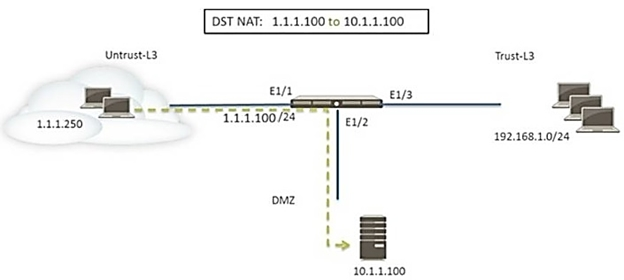Refer to the exhibit. A web server in the DMZ is being mapped to a public address through DNAT.

Which Security policy rule will allow traffic to flow to the web server?
Refer to the exhibit. A web server in the DMZ is being mapped to a public address through DNAT.

Which Security policy rule will allow traffic to flow to the web server?
To allow traffic to flow to the web server in a destination NAT setup, the security policy must consider the pre-NAT IP address and the post-NAT zone. In this case, the pre-NAT IP address is 1.1.1.100, which is the public address mapping to the server, and the post-NAT zone is DMZ. Therefore, the security policy rule that allows traffic from the Untrust zone to the DMZ, with the pre-NAT IP address of 1.1.1.100 for web browsing, is correct.
C is the correct answer. Remember for Security Policy lookup, the firewall uses Pre-NAT IP and Post-NAT Zone. https://docs.paloaltonetworks.com/pan-os/10-0/pan-os-admin/networking/nat/nat-policy-rules/nat-policy-overview.html
C. because security policy is pre-NAT IP + post-NAT ZONE.
C is correct. I got this question on the PCNSA, and so I wouldn't expect to see it on the PCNSE.
I believe the correct answer is 'B' Since this is DNAT setup, rule for security policy is: PRE-NAT addresses, POST-NAT zone. PCNSA study guide PAN OS 10.0, p.111
Pardon me - 'C' is the answer with POST-NAT zone.
https://docs.paloaltonetworks.com/pan-os/10-1/pan-os-networking-admin/nat/nat-policy-rules/nat-policy-overview
Answer should B
Correct Answer https://docs.paloaltonetworks.com/pan-os/8-0/pan-os-admin/networking/nat/nat-configuration-examples/destination-nat-exampleone-to-many-mapping
the corrct answer is D
No it's not. C is correct. the pre-NAT address is required as the destination in the security rule
no, C, It then evaluates and applies any security policies that match the packet based on the original (pre-NAT) source and destination addresses, but the post-NAT zones
Should that not be D based on https://docs.paloaltonetworks.com/pan-os/10-1/pan-os-networking-admin/nat/nat-configuration-examples/destination-nat-with-port-translation-example#id053beeb9-fde0-445b-99d0-5dd5a1000b7c ?
that should be C as mentioned on the question, it was natted.
Answer is C
D is the correct answer. the question is about security policy and the destination is 10.1.1.100